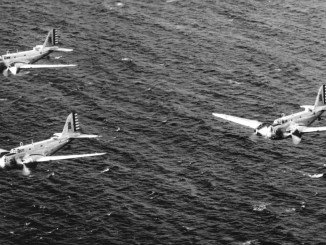
Originally designed in response to a challenge by Lord Rothermere for a high-speed passenger aircraft, the Bristol Blenheim was a light bomber of the Royal Air Force. The design by the Bristol Aeroplane Company proved to be faster than cotemporary fighter aircraft, and so the RAF quickly issued a specification for a bomber version. Named Blenheim after the famous battle of 1704, the new bomber began to enter service in 1937.
Unlike the civilian version the Blenheim had the wing mounted mid-fuselage, to allow for the installation of a bomb bay. It was powered by Bristol’s own Mercury engine, and initially fitted with a pair of defensive machine guns – although many more would be added as the design was improved in later models. The original step-less cockpit design was later replaced by a lengthened nose which provided more room for the bombardier to work.
In the first weeks of the war Blenheims mounted attacks on targets in Germany, where it was discovered that the aircraft was already approaching obsolescence – it was extremely vulnerable to fighters and flak. During the Battle of Britain, Blenheims mounted raids on German airfields in occupied Europe with modest success, but it was clear that better bombers were needed. Several hundred Blenheims were converted to long-range fighters or night fighters.
Despite the bomber’s problems in Europe the RAF believed that it was perfectly adequate for operations against supposedly inferior Japanese aircraft. Blenheims therefore made up the majority of the RAF bomber force in Malaya when the war began in December 1941. However, Japanese fighters and flak proved just as capable of shooting down the Blenheim as those of the Germans, and most were destroyed in the first few days of the conflict.
Other squadrons based in Burma and India proved that the Blenheim could still operate with reasonable effectiveness, although as soon as better aircraft like the Bristol’s new Beaufort and Beaufighter became available they quickly replaced the older model.
Bristol Blenheim Specifications
| Bristol Mk I Blenheim | |
| Role | Light bomber |
| Crew | 3 |
| Powerplant | 2x Bristol Mercury VIII (825hp) |
| Speed | |
| Ceiling | 0ft |
| Range | |
| Armament | 1x Vickers K 1x Browning M1919 .303in Machine Gun |
| Ordnance | 992lb bombs |
| Dimensions | 0ft 0in (length) 0ft 0in (wingspan) 0ft 0in (height) |
| Weight | |
| Number produced | 1,552 |
| Bristol Mk IF Blenheim | |
| Role | Night fighter |
| Crew | 3 |
| Powerplant | 2x Bristol Mercury VIII (825hp) |
| Speed | |
| Ceiling | 0ft |
| Range | |
| Armament | 4x Browning M1919 .303in Machine Gun |
| Ordnance | |
| Dimensions | 0ft 0in (length) 0ft 0in (wingspan) 0ft 0in (height) |
| Weight | |
| Radar | AI Mk IV (Air intercept radar) |
| Bristol Mk IV Blenheim | |
| Role | Light bomber |
| Crew | 3 |
| Powerplant | 2x Bristol Mercury XV (825hp) |
| Speed | 198mph (cruise) 266mph (max) |
| Ceiling | 27,260ft |
| Range | 1,460 miles (internal) |
| Armament | 5x Browning M1919 .303in Machine Gun |
| Ordnance | 1,200lb bombs |
| Dimensions | 42ft 7in (length) 56ft 4in (wingspan) 9ft 10in (height) |
| Wing Area | 469 sq.ft. |
| Weight | 9,790lb (empty) 14,400lb (gross) |
| Number produced | 3,307 |
| Bristol Mk V Bisley | |
| Role | |
| Crew | |
| Powerplant | 2x Bristol Mercury 25 (825hp) |
| Speed | |
| Ceiling | 0ft |
| Range | |
| Armament | |
| Ordnance | |
| Dimensions | 0ft 0in (length) 0ft 0in (wingspan) 0ft 0in (height) |
| Weight | |
| Number produced | 942 |




Leave a Reply